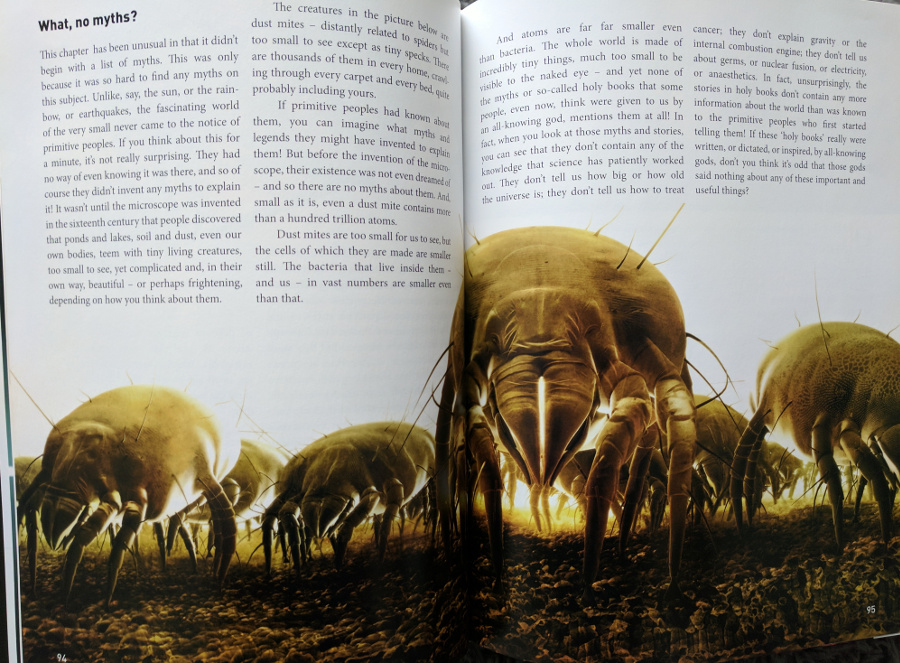Review: The Magic of Reality
There are countless science books for kids, teens and lifelong learners, with titles like “How Much is a Million?” or “Tiny Creatures: The World of Microbes”. The best of these books celebrate wonder and the beauty of elegant explanations. Most avoid the rocky terrain of religion and spirituality. Why limit the audience of a general science book by engendering controversy and criticism?
But Richard Dawkins is no stranger to controversy. With books like “The God Delusion”, he has become a leading figure of the New Atheist movement. As an evolutionary biologist, he has been especially concerned with the religious efforts, sometimes masquerading as science, to promote creationism and undermine science. His book “The Greatest Show on Earth: The Evidence for Evolution” (reviews) remains one of the best general introductions to evolutionary biology I know.
“The Magic of Reality”, as its title suggests, has an even larger scope: it seeks to foster curiosity and contrasts scientific explanations for life, the universe and everything with mythology. Its target audience are teens, though the book is readable with some help by younger kids and enjoyable for older readers as well.
The book is richly illustrated by Dave McKean, whose previous work has helped bring to life stories by Ray Bradbury, Neil Gaiman, and Stephen King. You may want to invest in (or borrow) the hardcover edition, which gives the photos and illustrations the space they deserve.
Given its large scope, the selection of topics in “Magic” is necessarily somewhat arbitrary. The chapter headings are:
-
What is reality? What is magic?
-
Who was the first person?
-
Why are there so many different kinds of animals?
-
What are things made of?
-
Why do we have night and day, winter and summer?
-
What is the sun?
-
What is a rainbow?
-
When and how did everything begin?
-
Are we alone?
-
What is an earthquake?
-
Why do bad things happen?
-
What is a miracle?
Most chapters begin with myths, and biblical myths get no special treatment here: stories by “Tasmanian aborigines” are told side-by-side with those of “the Hebrew tribes of the Middle East”. This diversity is very refreshing, and the illustrations help the reader to immerse herself in each myth or story.
This is followed by Dawkins’ best shot at an explanation for the “real story”, ranging from evolution by natural selection to tectonic plates, the refraction of light, or the Earth’s tilted axis of rotation relative to its orbital plane.
A few times, Dawkins writes things like this:
Well then, does our quest to cut things ever smaller and smaller end with these particles: electrons, protons and neutrons? No—even protons and neutrons have an inside. Even they contain yet smaller things, called quarks. But that is something I’m not going to talk about in this book. That’s not because I think you wouldn’t understand it. It is because I know I don’t understand it.
Dawkins’ willingness to admit ignorance and uncertainty, too, is refreshing, though there are times when then book would have benefited from a co-author with a different background (a physicist, for example) to flesh out an explanation. The quoted passage is perhaps one of those times: quantum physics is wild and beautiful enough to deserve more space in a book about the magic of reality.

Almost every page is illustrated with photographs or drawings. Most chapters begin with stories from mythology, but when talking about things that are small to see with the naked eye, Dawkins points out the notable absence of myths that predict or describe them.
Dawkins does succeed in making connections between the chapters, but overall, some topical transitions are a bit abrupt (“let’s talk about life on other planets - now let’s talk about earthquakes”).
Throughout the book, Dawkins acknowledges the beauty of myth while contrasting it with the “magic of the real”. He is especially critical of flimflam artists who try to convince people of supernatural powers, while his criticism of religion is not as pronounced and explicit as in some of his other works.
In the last chapter (“What is a miracle?”) the book echoes Carl Sagan’s “The Demon-Haunted World”, conveying similar lessons about critical thinking to a younger audience. Where Sagan gave his readers a “Baloney Detection Kit”, Dawkins uses a few simple examples (e.g., the Cottingley Fairies, the Fatima apparitions) to contrast the belief in miracles with more plausible explanations.
The Verdict
“The Magic of Reality” is a beautiful book, and I can recommend it as a gift, especially to curious younger people, or as a refresher intro to some basic scientific observations about the world we live in. It leaves the reader hungry for more, which is one of the best things one could ask for from a science book for young audiences. Its willingness to contrast science and myth makes it a relatively rare treat.
My main criticisms are that the book would have benefited from a bit more physics content, and more work on the overall narrative structure (through chronology, scale, historical figures, or some other structuring device). Recommended; 4 out of 5 stars.
